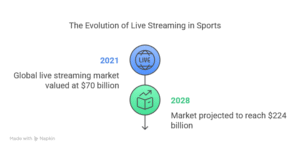I’ll never forget the rush of my first live-streamed football match. It was a rainy Sunday afternoon, and as the game unfolded in real-time on my screen, I wasn’t just rooting for my team—I was placing bets on the next goal, the number of corners, and even the final score. The experience was electric, blending the intensity of the match with the instant thrill of betting, all made possible by live sports betting platforms.
That moment opened my eyes to how these platforms are transforming the way we engage with sports, turning passive viewers into active participants. Today, real-time viewing isn’t just enhancing entertainment—it’s revolutionizing the betting landscape, and I’m here to dive into how it’s changing the game for fans and bettors alike.
The Evolution of Sports Betting: From Bookmakers to Digital Dominance
Sports betting has deep roots, stretching back to ancient civilizations where wagers were placed on chariot races and gladiator fights. Fast forward to the modern era, and it was bookmakers who shaped the industry, taking bets on horse races and sporting events from smoky backrooms or bustling high streets. Bettors had to show up in person, cash in hand, to get in on the action.
Then came the internet in the late 1990s, a seismic shift that birthed online betting platforms. Suddenly, you could place a wager from your living room, no travel required. The rise of smartphones took it further—mobile apps like Bet365 and DraftKings made betting as easy as a tap on your screen, anytime, anywhere. This accessibility fueled explosive growth, with the global sports betting market valued at over $85 billion in 2023, according to Statista.
The game-changer for the U.S. came in 2018 when the Supreme Court struck down the federal ban on sports betting. States like New Jersey and Pennsylvania jumped in, legalizing and regulating the industry, sparking a market boom projected to hit $45 billion by 2028, per Grand View Research. This evolution set the stage for live sports betting platforms to merge seamlessly with real-time viewing, taking the experience to new heights.
The Rise of Live Streaming: A New Era for Sports Fans
Live streaming has surged in popularity, driven by tech advancements and our craving for instant, on-demand content. Platforms like Twitch, YouTube Live, and sports-specific services such as ESPN+ have made it possible to watch games from anywhere—your couch, a coffee shop, or even halfway across the globe.
The numbers tell the story: the global live streaming market was valued at $70 billion in 2021 and is expected to reach $224 billion by 2028, with sports as a major driver, according to MarketsandMarkets. Why the boom? It’s simple—live streaming offers flexibility.
Fans can watch multiple games at once with features like split-screen viewing, catch niche sports like rugby or esports that rarely make it to cable, and enjoy it all on their phones or tablets, thanks to widespread high-speed internet.
For me, it’s the freedom to follow a Premier League match while keeping tabs on an NBA game that’s hooked me. This accessibility has paved the way for live sports betting platforms to thrive, merging real-time viewing with real-time wagering in ways we couldn’t have imagined a decade ago.
How Live Streaming is Transforming the Betting Landscape
The fusion of live streaming and betting has sparked a revolution, with in-play betting—also called live betting—leading the charge. Unlike traditional pre-game bets, in-play betting lets you wager as the action unfolds. Think betting on the next team to score in a soccer match or whether a basketball player sinks their next free throw. It’s fast, dynamic, and fueled by the immediacy of live streams.
This shift has unleashed a flood of new betting options. On platforms like FanDuel, you can bet on micro-events—will the next play in an NFL game be a pass or a run? Will a tennis player win the next point? Real-time data from the game feeds these opportunities, making every second a chance to win. A 2022 report by H2 Gambling Capital found that in-play betting now accounts for over 50% of online sports betting revenue globally, a testament to its growing dominance.
What’s more, watching the game live through live sports betting platforms lets you make sharper decisions. I’ve adjusted bets mid-match after seeing a key player limp off or a team gain momentum—insights you’d miss without real-time visuals. This keeps bettors glued to the screen, boosting engagement.
Many platforms enhance this with live stats, odds updates, and interactive features, turning betting into a fully immersive experience.
But there’s a flip side. The constant action can blur the line between fun and obsession. The ease of placing bets in seconds has raised red flags about gambling addiction, prompting calls for stronger safeguards. Operators like Betfair now offer tools like deposit limits and self-exclusion options, but it’s a reminder that with great thrill comes great responsibility.
The Technology Powering Live Sports Betting Platforms
Behind the scenes, cutting-edge tech makes this seamless integration possible. Low-latency streaming is the backbone—any delay between the live event and your screen could throw off an in-play bet. Platforms use WebRTC, a real-time communication protocol, to slash latency to mere milliseconds, ensuring you’re betting on what’s happening now, not five seconds ago.
Real-time data analytics are the brains of the operation. Sophisticated algorithms crunch game data—player stats, ball possession, momentum shifts—and adjust odds on the fly. AI takes it further, analyzing historical trends and live inputs to predict outcomes with uncanny accuracy. For instance, Sportradar provides data solutions that power many live sports betting platforms, delivering insights that keep odds sharp and bettors informed.
The infrastructure is just as critical. Secure payment systems handle millions of transactions, while scalable servers manage peak traffic—like during the Super Bowl, when bets spike. A glitch-free experience is non-negotiable, and companies invest heavily to keep it smooth. It’s this tech trifecta—low latency, smart analytics, and robust systems—that’s driving the live betting revolution.
Benefits and Challenges of Real-Time Betting
| Aspect | Details |
|---|---|
| Benefits |
|
| Challenges |
|
Balancing these pros and cons is key to keeping live sports betting platforms sustainable and fun for everyone.
The Future of Live Sports Betting: What’s Next?
The horizon is buzzing with potential. Augmented reality (AR) could overlay live stats—like a player’s shooting percentage—right on your screen, making bets even more informed. Imagine watching an NBA game with AR goggles, seeing odds shift in real-time as you glance at the court.
Blockchain is another game-changer. By logging bets on a transparent, tamper-proof ledger, it could boost trust and security. Platforms like Wagerr are already exploring this, hinting at a fraud-free future.
Globally, the market’s set to expand as more countries, like Canada and India, loosen betting laws. This could spark a wave of innovation, with live sports betting platforms rolling out features tailored to local sports and cultures. The possibilities are endless—and thrilling.
Conclusion: A New Game in Town
Live streaming has turned sports betting into an interactive, adrenaline-fueled experience, with live sports betting platforms at the heart of the shift. From the evolution of bookmakers to the promise of AR and blockchain, this fusion of tech and entertainment is rewriting the rules. It’s not just about watching anymore—it’s about living every moment, bet by bet.
Have you jumped into live sports betting yet? Drop your thoughts or favorite moments in the comments—I’d love to hear how it’s changed your game! For more on this exciting trend, check out our posts on sports tech innovations or responsible gambling tips.

















